Environmental conditions check
Back to: Propagating Seedstring from Gametophytes
The care for gametophyte-painted spools and spore-seeded spools differs slightly, but the general rules remain the same based on the life-stage of the seed, which can be assessed under the microscope. Water quality, light levels, and nutrient levels can all have significant negative effects on the spools if they are wrong. When sporophytes are just forming, stressful conditions will have a bigger impact on their development than when they are grown out. If the light is too high, the sporophytes may bleach, but if it’s too low, the sporophytes will grow too slowly and the total time in the nursery will increase. More time in the nursery means more resources used. There is no major risk to the sporophytes of the nutrients being too high, but excess nutrients may allow contaminants to grow faster and also result in wasted materials. Use the Environmental Conditions Chart to know what conditions are right for each spool stage.
Keep track of spool maintenance and conditions in the tanks throughout the nursery season with log sheets. There is a lot of information to be collected from each tank each day, so tracking will be useful when planning for other seasons, tracking failures, and recording contamination outbreaks. An example of a tracking sheet can be found here. Make sure anyone who is operating your nursery is familiar with log sheets and is using them consistently. Each day you will want to do three categories of checks.
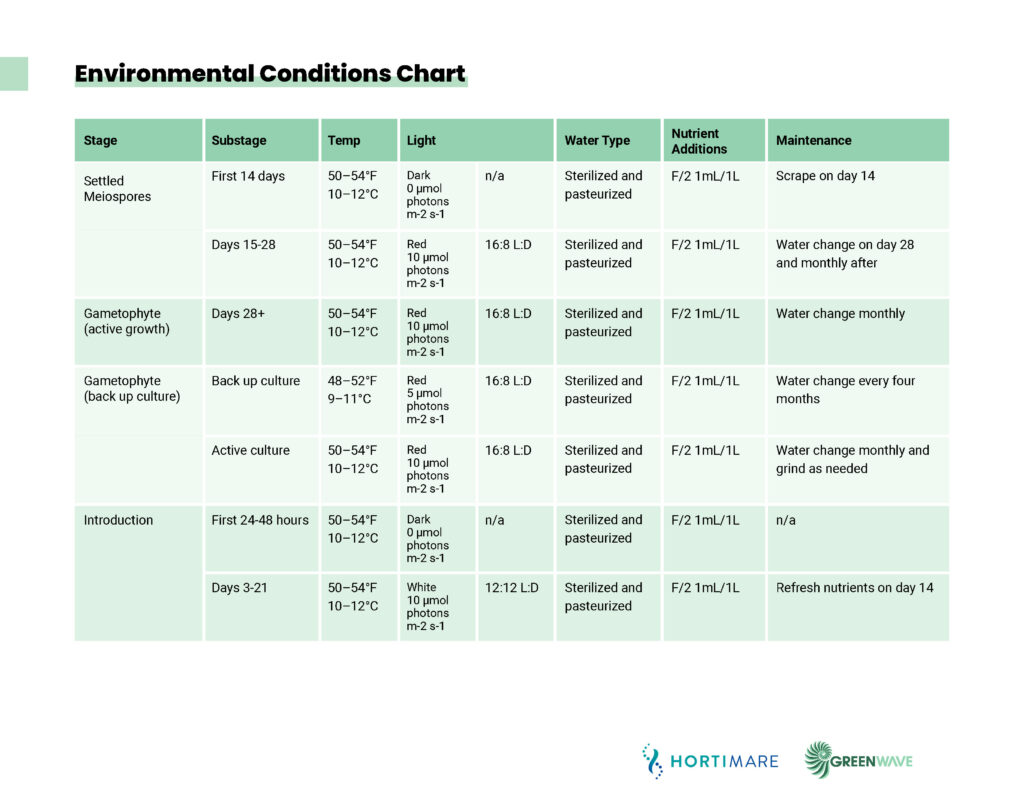
-
-
Health check
-
Equipment/system check
Environmental Conditions Check
You need to make sure that the conditions in your tank are right for the seed by checking pH, temperature, and salinity on a daily basis, as well as adjust light levels, flip/turn your spools, and add nutrients. Your goal in the nursery is to create the perfect environment for juvenile kelp.
-
pH
The pH in your tanks should stay within 7.0–9.0. Remember that pH is a logarithmic scale, so small decimal places can actually mean a significant difference in conditions. You can find a decent pH meter for relatively cheap. GreenWave prefers the Hanna brand pH meter or combo probe.
Use a pH probe to check the pH in your tanks.
-
Aeration
Aeration is important in your grow tanks to create water movement around your spools and help manage the pH. You can use aquarium air pumps and air stones or air manifolds to achieve this. For any air going into your tank, you should use in-line air filters.
-
Salinity
Salinity in your tank should be between 28–34 ppt. You can measure the salinity with a refractometer. Your exact numbers may vary based on the region you are growing in. It is best to compare your tank conditions to the natural water conditions from your collection locations. If you are pumping in seawater, the salinity will normally be within the safe range as long as you are not pumping from an area with a lot of freshwater input. Evaporation in your nursery can also impact your salinity. If you have a lot of evaporation from your tanks in your nursery, monitor the salinity very closely and consider using tank covers. If your salinity gets too high, do a 50% water refreshment. If your water source has too low salinity, you may need to supplement with Instant Ocean or another salt water media mix.
-
Temperature
The water temperature in your tanks should be 10–12°C (50–54°F). Colder temperatures may slow growth and warmer temperatures will stress the kelp.
-
Light levels/cycles
Check that your light timers are working weekly. Adjust the light levels and cycles for your tanks according to the Environmental Conditions chart. Use a full spectrum PAR meter to measure this. GreenWave uses this Apogee PAR meter. Measure the PAR from a position that is similar to the spools’ positions. At GreenWave, we use top lights so we measure the par from the top of the water column, about 1–2 inches below the water surface.
Use a PAR meter to measure the light intensity in your grow tanks or culture room.
PAR is photosynthetically active radiation. The wavelengths of light within the visible range of 400-700 nanometers, which are used for photosynthesis.
-
Nutrients
Your kelp needs ample nutrients to fertilize and grow. GreenWave uses an F/2 solution made from F/2 powder for dosing our grow tanks. Since we have flow-through tanks that refresh at 100% daily, we dose with 1 mL of F/2 per 10 L of seawater in our tanks two times per day, typically around 8:00 am and 5:00 pm. This number may change if you don’t have flow-through tanks or aren’t changing 100% of the water per day. You can refer to the Environmental Conditions chart to see how the dosing changes throughout the season or with different refreshment rates.
-
Flip/spin spools
Depending on your light source, you will need to either flip or spin your spools once every two days. For top lighting, flip spools. For side lighting, spin spools. However, if you are using LEDs and lighting from the side, you may need to both flip and turn your spools to avoid banding.
Flipping your spools, when using top light, and turning them, when using side light, helps promote even growth.
Health Check
Click the icons to learn how and what to check the health of your spools.
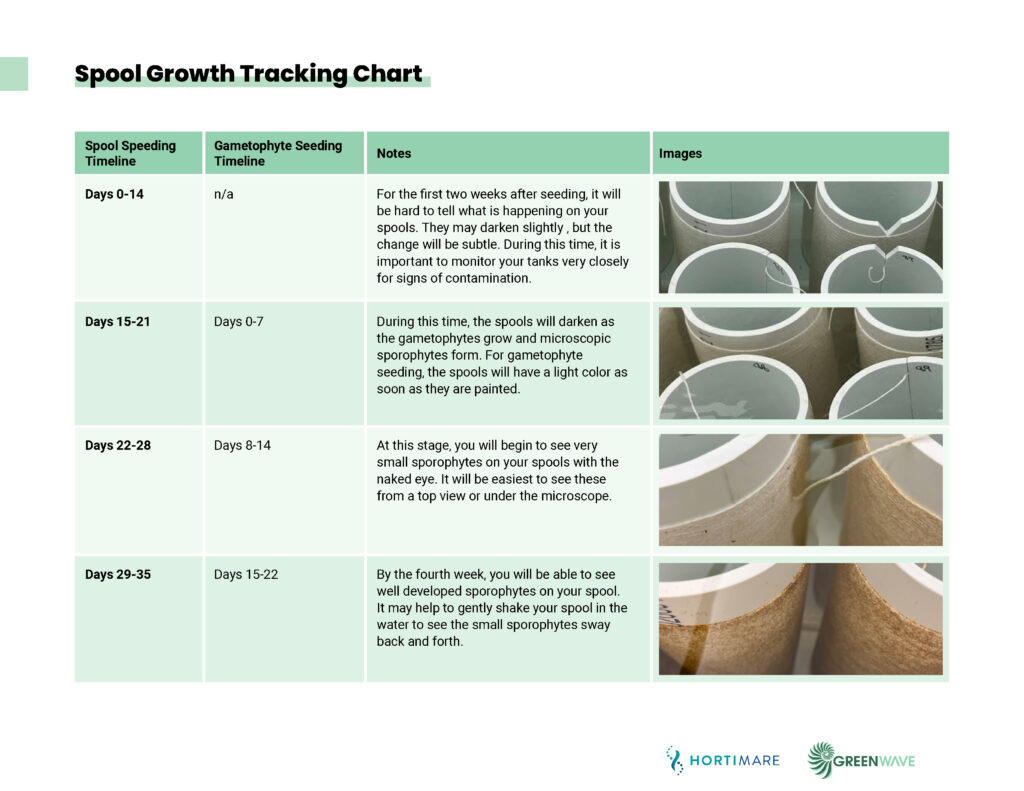
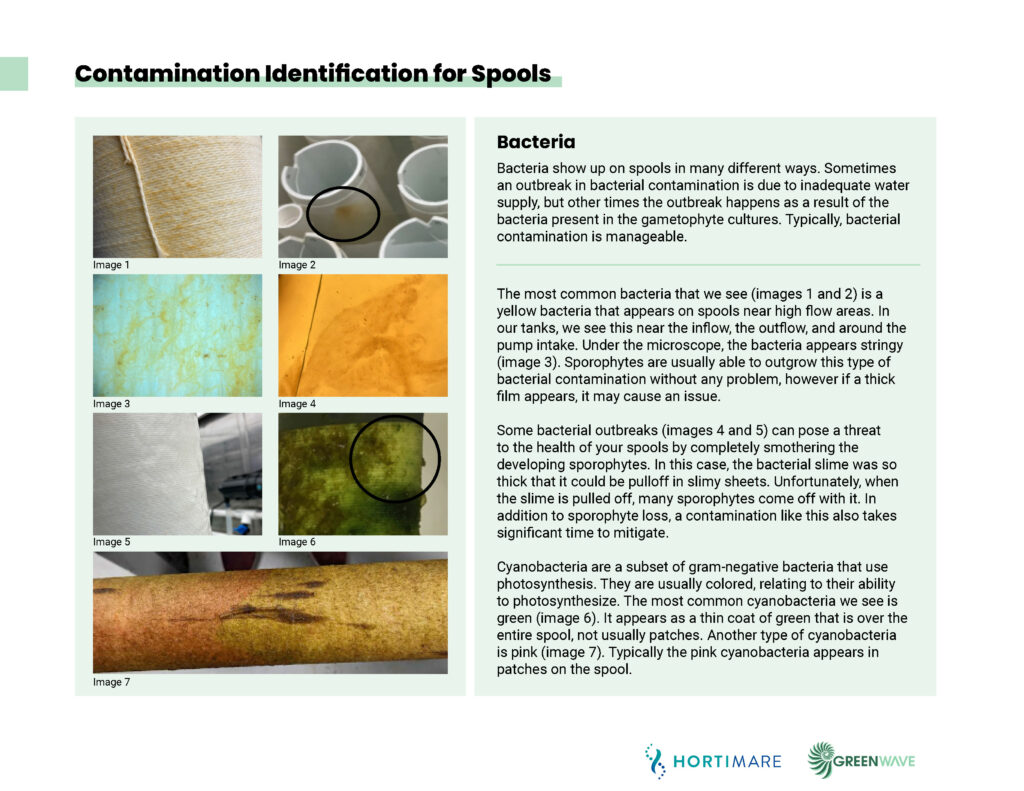
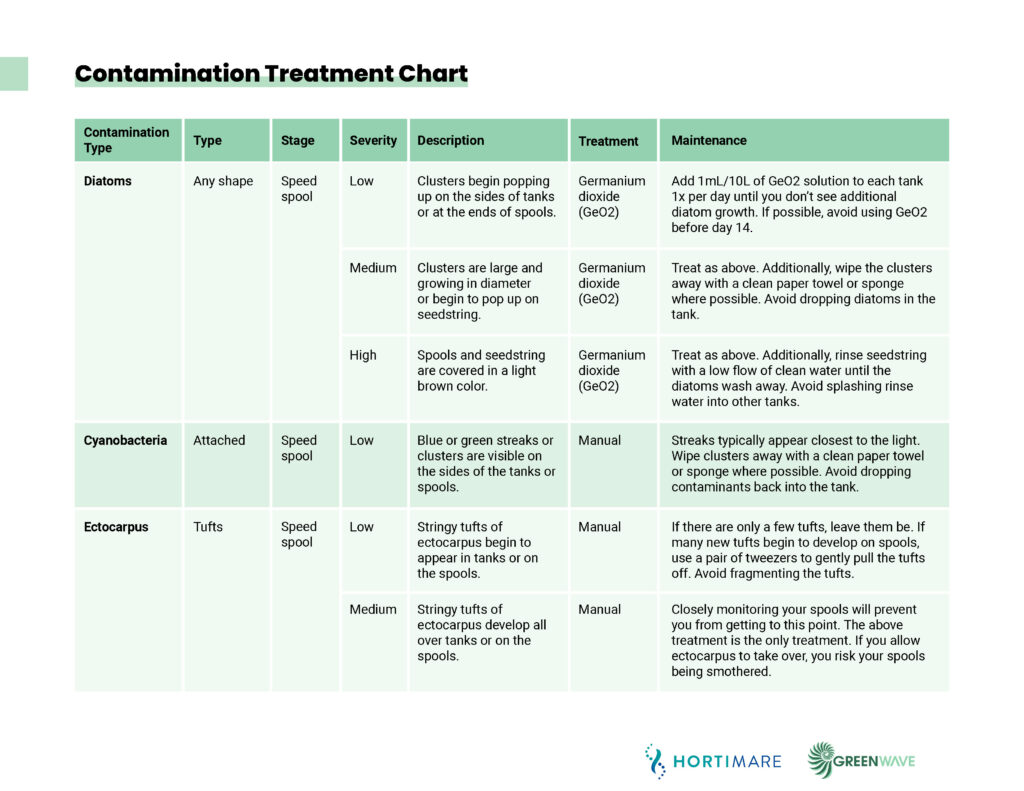
Equipment/System Check
Your nursery system has a lot of moving parts. If an integral part stops working, you can have nursery failures. Because of this, it is important to check to make sure your system is in working order each day. Common issues might include air or water filters and pumps clogging, light timers breaking or getting off schedule, or cooling equipment breaking or lagging. It is also important to check that your drains are draining properly, you don’t have any dirty stagnant water, and your water inflow is the right strength. GreenWave keeps our water flow into each tank at 100% daily for the first few weeks of the season, so we measure the inflow into each tank volumetrically every couple of days. It is a good idea to have extras of each tank component on hand in case one breaks or clogs.
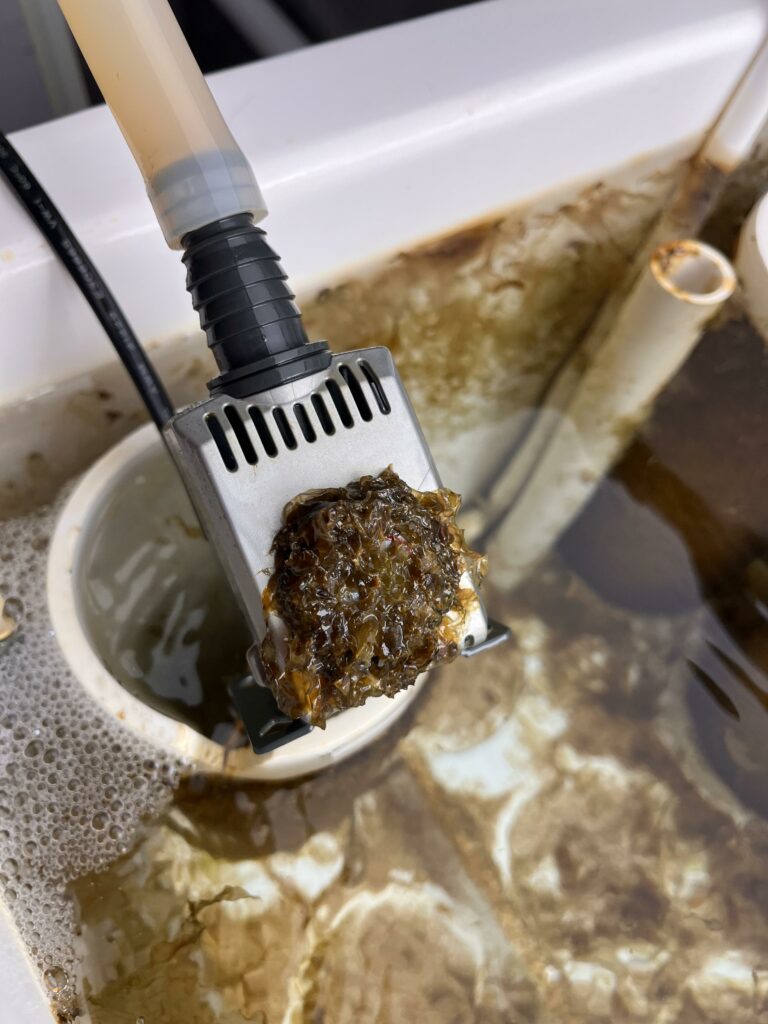
This water pump from a nursery tank is clogged with sporophytes.The intake should be cleared out using a clean brush or paper towel.
WATCH VIDEOThe difference between the UV lamp on and UV lamp off is subtle. It’s important to check your system carefully and frequently.
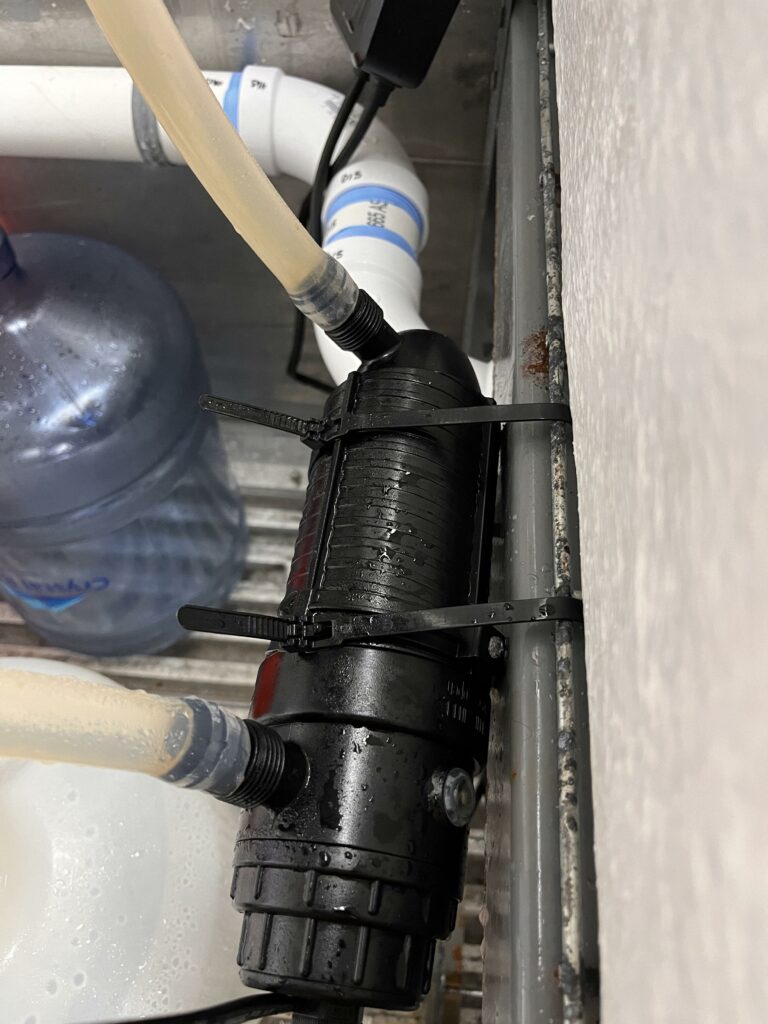
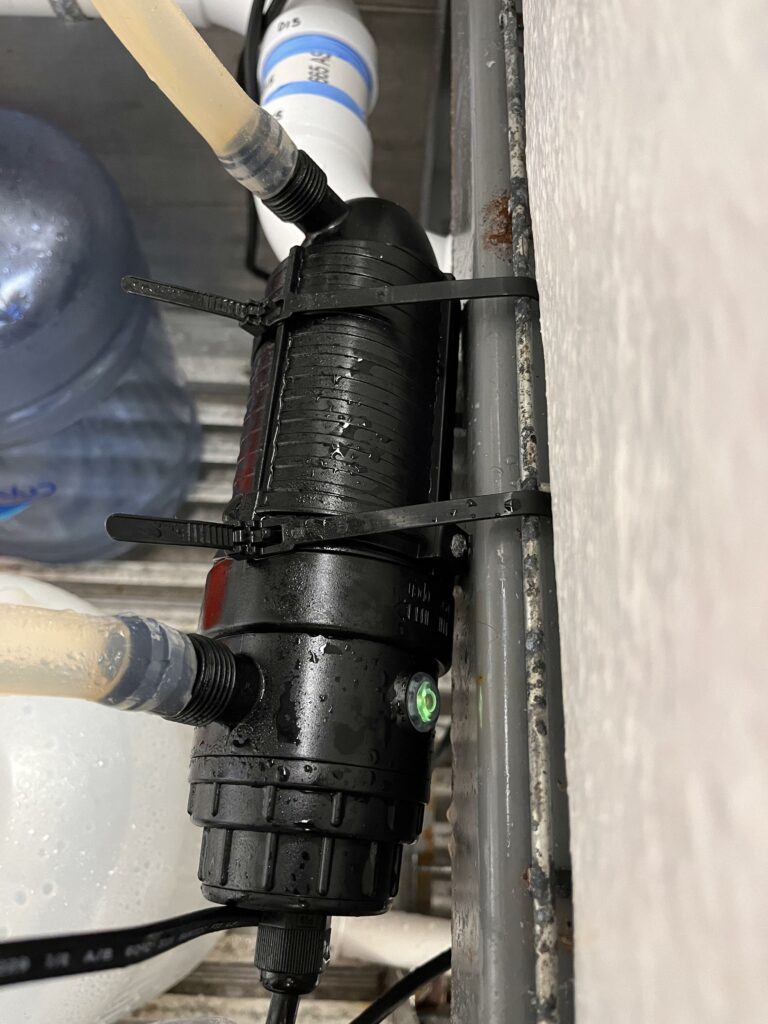
Troubleshooting
Each nursery system is unique and may run into its own specific problems. Troubleshooting will look different for everyone, but it is never a bad idea to reach out to other nursery operators you know for help. You can use the Community section of GreenWave’s Ocean Farming Hub to post questions and join conversations about nursery troubleshooting.